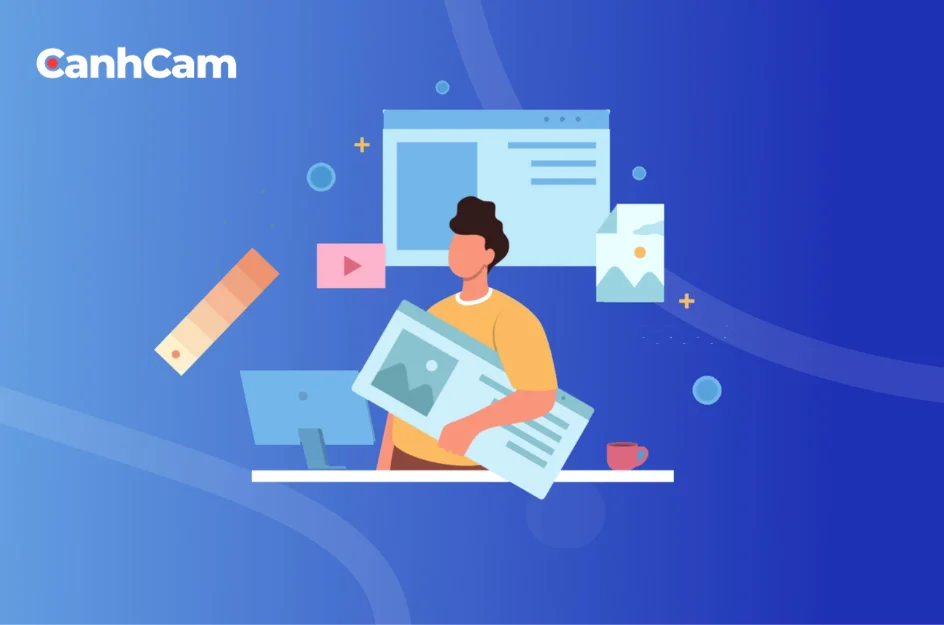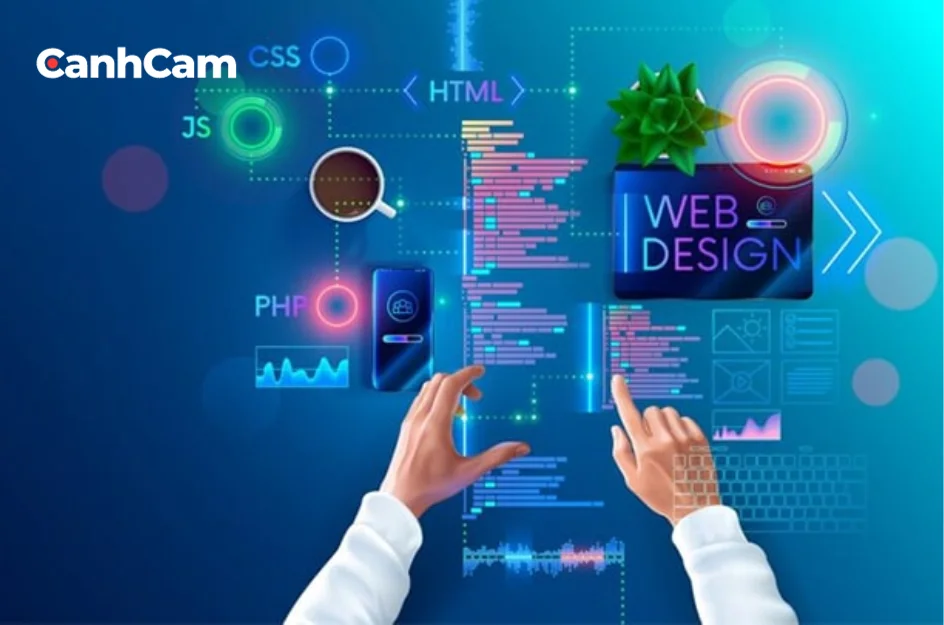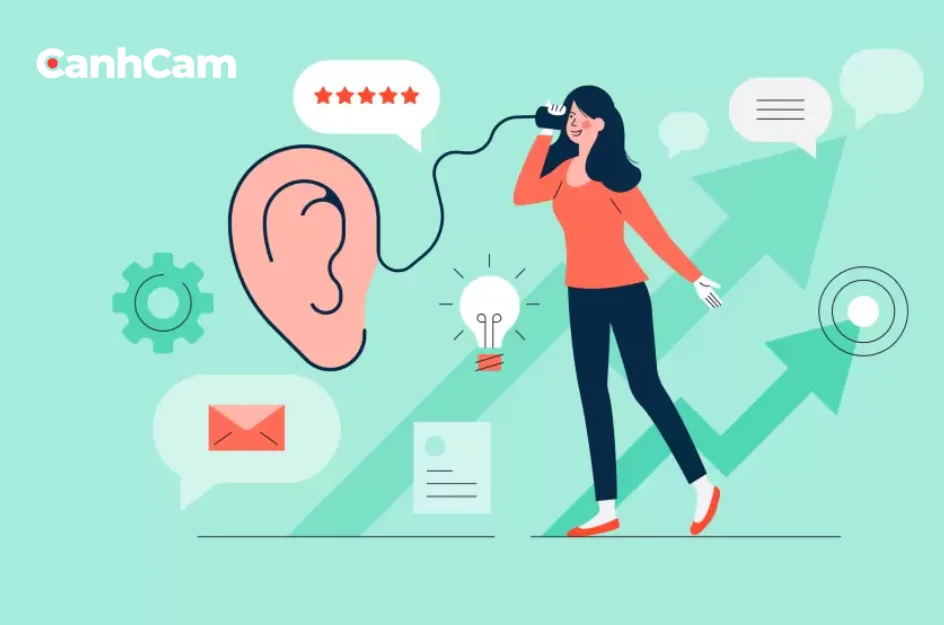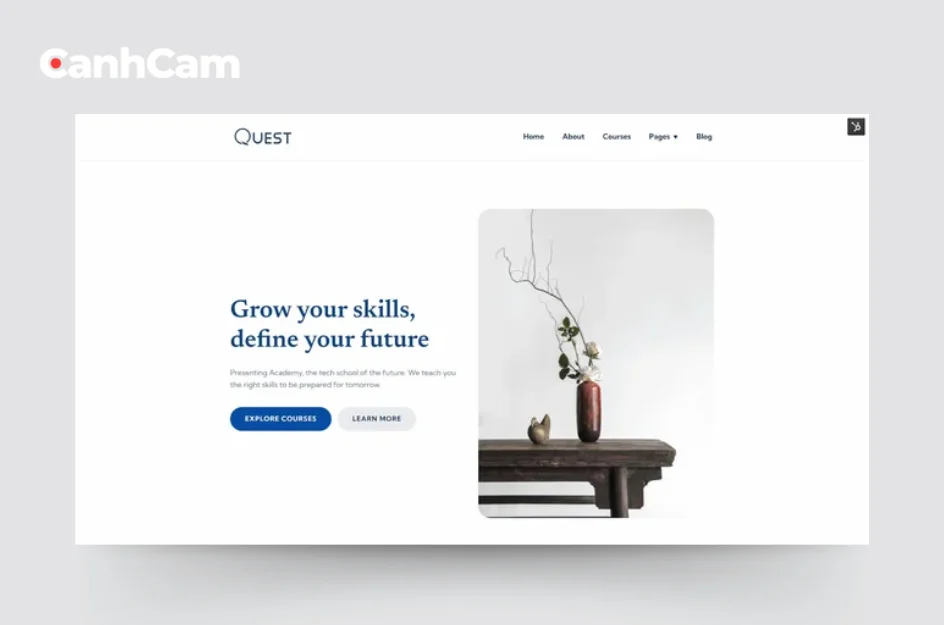The crux of success in today's digital era lies in the effective design and development of websites, seamlessly blending creative artistry with technical expertise. A strong online presence is crucial for the success of businesses, organizations, and individuals.
The significance of website design and development has surged, prompting CanhCam to delve into the details in an upcoming article. Stay tuned for insights into the intricacies of designing and developing websites.
The Different of Design and Development of Websites
If you're aspiring for a career in the design and development of websites, here is a different:
What is Website design?
Website design involves optimizing a site's usability and appearance. Web designers focus on elements like the layout and colour scheme to create visually appealing and user-friendly websites. The primary aim is to enhance the overall user experience, ensuring the site is easy to navigate and aligns with the brand identity. Key aspects of website design encompass storyboards, logo design, format, UI & UX design, and colour palettes.

What is website development?
Website development involves the design and development of websites, focusing on the mechanisms that ensure proper functionality. Web developers, divided into front-end and back-end categories, play a crucial role in bringing a web designer's ideas to life through coding.
Front-end developers concentrate on code that dictates the website's appearance, while back-end developers manage data within the site's database, enabling its display on the front end. These programmers, equipped with coding skills, translate designers' wireframes into code using HTML, CSS, and JavaScript, implementing visual assets like images, colour schemes, and fonts into the page.
What is the difference?
A web designer focuses on creating the visual layout and usability, while a web developer constructs and upholds the website's core structure. A proficient web designer requires a mix of creative, graphic, and technical skills.
Conversely, a web developer transforms the design into a functional website, employing coding languages like HTML, JavaScript, PHP, and Python. To embark on a career in this field, it's crucial to comprehend these distinct roles and acquire the necessary qualifications and skillsets.
The Significance of Website Design and Development
The importance is in establishing a strong online presence, improving user satisfaction, and promoting company expansion. In addition to drawing traffic, well-designed websites can increase consumer involvement and brand credibility. To guarantee both functionality and visual appeal, the process entails planning, coding, and designing.
Navigation of Website
Efficient and intuitive navigation is vital for visitors to quickly find what they seek. A poorly navigated site can impede users from exploring further or lead to them abandoning the site. Prioritizing navigation ensures that users can easily access various sections and pages, thereby enhancing the overall user experience.

Visible and written components
A succinct and impactful message is more likely to resonate and linger in the minds of readers. Hence, web design and development resources must be straightforward, enabling designers to seamlessly incorporate them into their designs.
Visual elements such as images, videos, and graphics can augment the website's aesthetic appeal, captivating users' attention and effectively conveying information. Similarly, well-crafted content is crucial for delivering messages clearly and attractively to users.
By amalgamating visually appealing elements with well-written content, websites can adeptly communicate their brand message to users and distinguish themselves from their competitive counterparts.
Brand Integrity
The website functions as the virtual representative of an organization or business, and its design should align seamlessly with the brand's values, mission, and identity. Consistent utilization of colours, fonts, and visual elements aids users in recognizing and associating the website with the brand.
By prioritizing web design and development to uphold brand integrity, developers can establish a unified online presence that reinforces brand identity in users' minds.
All distinctive elements of your company's logo utilized in print materials should be seamlessly integrated into your website's style to ensure unwavering consistency.
Minor alterations to your brand and visual communication can potentially confuse customers, leading them to believe that something significant is amiss with your company.
Interaction
Websites have evolved beyond static pages and now function as interactive platforms that actively encourage user engagement. Features like user-generated content, social media integration, live chat support, and feedback forms create an environment conducive to meaningful interaction between users and the website.
This interaction not only builds trust and fosters customer loyalty but also enables businesses to collect valuable feedback and data for future improvements or decision-making.
How Does Website Development And Design Impact Business Profitability?
The factors related to user experience, online interaction, and the market all contribute to determining the attractiveness and business performance of a website. Let's explore these crucial factors together and understand their significance for the success of a business in today's online business environment.
Expense reduction
It is essential to highlight that website design and development services come at a reasonable cost. Web administrators construct websites with significantly lower expenses by carefully structuring content. The cost-effectiveness of the website extends to the long-term benefits it brings to the company. Additionally, the website also reduces the time and effort required for direct customer interactions.

E-commerce
The development and design of a website empower businesses to leverage the immense potential of web design and development in e-commerce, revolutionizing the way products and services are bought and sold.
With a well-designed website, businesses can establish a global online presence, breaking down geographical barriers and reaching customers worldwide. This expansion of the customer base leads to increased revenue and profitability.
Furthermore, e-commerce enabled by proficient web design and development allows businesses to operate 24/7, eliminating constraints imposed by traditional brick-and-mortar stores.
This capability enables businesses to generate revenue even outside regular working hours, further enhancing profitability.
Enabling website advertisements
Efficient website development and design not only create a digital presence but also unlock opportunities for revenue generation through website advertising.
By strategically placing ads on their website, businesses can establish additional income streams through partnerships with other companies or display advertising networks.
These strategically placed ads can target specific audiences, resulting in higher conversion rates and increased financial profits. Revenue generated through website advertising, supported by effective web design and development, contributes significantly to the overall profitability of the business, offering avenues for growth and expansion.
Enhancing customer experience and satisfaction.
A well-designed website, characterized by ease of navigation, visual appeal, and prompt feedback, leaves a positive impression on users, fostering trust and reliability.
This positive interaction, facilitated by web design and development in the context of e-commerce, leads to increased customer loyalty and repeat business.
A favourable online presence not only retains existing customers but also attracts new ones, as users tend to associate an attractive website with a trustworthy and high-quality business.
This, in turn, contributes to the overall enhancement of customer experience and satisfaction in the realm of ecommerce.

Things to Know When Designing and Developing Websites
Owning a comprehensive understanding of the key principles is crucial for designing and developing the most effective website. Whether you are an experienced expert or just beginning your digital journey, grasping fundamental aspects is essential. Below are essential things you need to know to design and develop a website:
Making domain and host selections.
The choice of a domain name is a critical decision that should mirror the purpose and essence of the represented business or organization. It should be memorable, easy to spell, and ideally carry the .com extension for broader recognition.
Simultaneously, the selection of a reliable web hosting service provider is paramount to ensure the seamless operation of the website with minimal downtime. Factors such as server speed, security features, storage capacity, and customer support must be thoroughly evaluated before arriving at a final decision.
Backend services
Giving due consideration to auxiliary services is crucial. Incorporating a Content Management System (CMS) can significantly enhance the website's functionality and user-friendliness. For instance, WordPress provides a user-friendly platform facilitating easy content management and creation.
The integration of plugins and extensions further expands the website's capabilities, incorporating features like e-commerce functionality, contact forms, and social media sharing.
Simple design
In the realm of design, simplicity takes precedence. A cluttered and intricate design has the potential to confuse and drive away visitors. By concentrating on a clean and intuitive layout, users can effortlessly navigate the website and find the information they seek.
The adoption of responsive design is also imperative to ensure compatibility across various devices, considering the growing number of users accessing websites through mobile devices
Successful colour scheme
Understanding the psychological impact of colours is crucial in establishing a successful brand. For instance, navy blue may evoke feelings of trust and professionalism, while yellow signifies positivity and energy. Through careful selection and combination of colours, a website can create a visually appealing and emotionally resonant impression that aligns with the organization's brand image.
Branding
Branding stands as a pivotal element for any website, representing the identity of a business or organization and establishing a robust presence in the digital landscape. In every website project, I initiate by comprehensively understanding the brand's values, mission, and target audience.
Elements such as logos, colour schemes, typography, and imagery are meticulously chosen to align with the brand's identity, creating a cohesive and visually appealing website
Functionality
A website should not only possess visual appeal but also function effectively to meet user needs. Throughout the development process, I place careful emphasis on the functionality requirements of the website, ensuring it provides the necessary features and tools for users to interact seamlessly.
Whether it's an e-commerce website requiring a smooth checkout process or a blog website with user-friendly content management capabilities, functionality always takes precedence to enhance the overall user experience.
Navigation
Navigation stands as a crucial determinant of a website's success. Visitors should effortlessly find what they seek and navigate through the site without confusion or frustration. To achieve this, I meticulously plan and structure the website's information architecture, ensuring that the layout and content organization are logical and intuitive.
Employing techniques such as clear and visible menus, a search function, and breadcrumbs enhances navigation, ensuring a smooth user experience.
Usability
Usability refers to how easily users can navigate and interact with a website. It is vital to design a website layout that is clean, organized, and user-friendly. The navigation menu should be easily accessible, clearly indicating different pages or sections of the website. Additionally, it is essential to ensure that crucial information, such as contact details, product descriptions, or pricing information, is easily found.
Call to action
A Call to Action (CTA) guides users toward taking a desired action, such as making a purchase, signing up for a newsletter, or contacting the company. It is crucial to include prominent CTA buttons or links strategically on the website, such as the homepage, product pages, or blog posts.
Effective CTAs should be visually appealing, concise, and action-oriented, and use persuasive language to communicate the value proposition of the action.
Rapid loading time
Ensuring rapid loading time requires optimizing the website by compressing images and reducing HTTP requests. Utilizing caching techniques and content delivery networks (CDNs) significantly improves loading times.
Additionally, it is crucial to maintain clean website code, free from unnecessary scripts or plugins that may impede the loading process. The goal is to provide users with a seamless and fast browsing experience.
Conclusion
The significance of web design and development cannot be overstated in the digital landscape. These aspects play a crucial role for businesses and individuals alike who aim to create a strong online presence and attract their target audience.
In the face of rapidly advancing technology, professionals in web design and development are constantly improving and expanding their skills to stay ahead in this ever-evolving industry. From perfecting responsive design to optimizing user experience, the realm of web design and development consistently shapes our interactions with the digital world.
Frequently Asked Questions (FAQs)
1. What are the 3 elements of an MVP?
Upon examining this definition, three main components emerge:
- An MVP contains a minimal amount of features.
- MVP must satisfy early customers.
- A minimum viable product supports the generation of feedback for further improvement.
2. What are MVPs and Examples?
MVP is a product that has enough features that attract early adopters and lengthen the brainstorming process for new products in the product development stage. In the software sector, an MVP is a quick way of letting users try out the product and providing quick feedback to the product team so that they can improve or add new features.
3. What are The Different forms an MVP can take?
MVP is the initial version of your product designed to gather customer feedback for iteration and improvement with minimal resources. MVPs can manifest in various forms, such as landing pages or prototypes. Validating an MVP is a crucial initial step before proceeding to build a more comprehensive product at scale.

